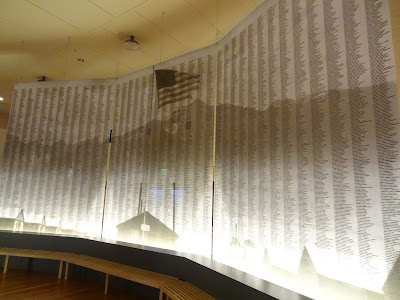Visited: Nov 2016
Nearby town: Lone Pine, CA
"My family and I were classified as enemy aliens simply because we looked like the enemy."
-former Congressman Mike Honda, who lived at an internment camp in southeastern Colorado as a young boy
The isolated and desolate Owens Valley, at the foot of the eastern edge of the Sierra Nevada in California, was the site of Manzanar, the largest camp used to relocate American citizens and immigrants of Japanese descent during WWII. From Dec 1942 to 1945, this rugged area was inhabited by over 120,000 Japanese-Americans, forced from their homes to relocate here due to rampant paranoia and prejudice.
This dark chapter of American history is memorialized at the Manzanar National Historic Site, preserving a history that needs to be encountered and studied, so hopefully it will never be repeated again.
I have covered most of the backstory of what lead up to the relocation camps in the blog post of our visit to Minidoka National Historic Site in Idaho. Instead of repeating the story I will simply leave a link to that post: https://paulnationalparks.blogspot.com/2018/10/minidoka-national-historic-site.html
Manzanar was a much bigger camp than the one in Idaho, and the visitor center here is much more developed and has more exhibits. Manzanar is the most comprehensive site for information on this episode of American history. The museum and grounds here is very somber and is a must-visit if you want to understand the relocation of Japanese-Americans to these camps.
After the attack on Pearl Harbor in Dec 1941 and Pres. Franklin D. Roosevelt issued Executive Order 9066, Manzanar was the first of 10 relocation camps to be built and established. Most of the Japanese-Americans that came here were from the Los Angeles area.
Life in the camp was rough: harsh conditions, harsh weather, and hardly any privacy. A number of families lived together in barracks. Food was heavily rationed, and people had to wait in lines to eat, to use the bathroom, to do laundry, etc. And they were continually monitored by guards in tall towers surrounding the camp armed with machine guns.
 |
| reconstructed barracks |
 |
| communal kitchen |
 |
| cafeteria |
 |
| interior of barracks |
 |
| names of internees who signed up to serve in the US Army |
Make sure to stop at the Visitor Center to watch the film and take your time to read all the exhibits. You really start to sense what these people went through and what life was like in these camps.
Make sure to take the drive through the camp and stop at the barracks and the cemetery towards the back end of the camp.
 |
| This monument at the cemetery was built in 1943, the inscription reads "Soul Consoling Tower" |
"My Mom, Pop, and Me"
My Mom, Pop, & Me
Us living three
Dreaded the day
When we rode away,
Away to the land
With lots of sand
My Mom, Pop, & Me
The day of evacuation
We left our little station
Leaving our friends
And my tree that bends
Away to the land
With lots of sand
My Mom, Pop & Me
-Itsuko Taniguchi
Manzanar was closed on November 21, 1945 and the US gave each individual $25 for one-way fare back to their homes. Many returned to nothing, their possessions stolen, and their homes taken. Let us never forget what happens when other factors supersede the constitutional rights guaranteed to all citizens and aliens living in this country.
For more info: https://www.nps.gov/manz/index.htm





















No comments:
Post a Comment